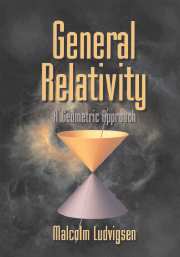Book contents
- Frontmatter
- Contents
- Preface
- PART ONE THE CONCEPT OF SPACETIME
- PART TWO FLAT SPACETIME AND SPECIAL RELATIVITY
- PART THREE CURVED SPACETIME AND GRAVITY
- 9 Curved Spacetime
- 10 Curvature and Gravity
- 11 Null Congruences
- 12 Asymptotic Flatness and Symmetries
- 13 Schwarzschild Geometries and Spacetimes
- 14 Black Holes and Singularities
- PART FOUR COSMOLOGY
- Solutions and Hints to Selected Exercises
- Bibliography
- Index
12 - Asymptotic Flatness and Symmetries
Published online by Cambridge University Press: 04 June 2010
- Frontmatter
- Contents
- Preface
- PART ONE THE CONCEPT OF SPACETIME
- PART TWO FLAT SPACETIME AND SPECIAL RELATIVITY
- PART THREE CURVED SPACETIME AND GRAVITY
- 9 Curved Spacetime
- 10 Curvature and Gravity
- 11 Null Congruences
- 12 Asymptotic Flatness and Symmetries
- 13 Schwarzschild Geometries and Spacetimes
- 14 Black Holes and Singularities
- PART FOUR COSMOLOGY
- Solutions and Hints to Selected Exercises
- Bibliography
- Index
Summary
As we move away from an isolated body, its gravitational field decreases and tends to zero as we approach infinity. In a spacetime picture, where gravity is described by curvature, it would therefore seem entirely reasonable to model an isolated body on a spacetime that is, in some sense, asymptotically flat. If the body possesses some sort of symmetry – it might, for example, be an axisymmetric or spherically symmetric star – then it would also seem reasonable to model it on spacetime with the same type of symmetry. But what exactly do we mean by asymptotic flatness, and what do we mean by a spacetime symmetry? In this chapter we shall attempt to answer these two questions.
Asymptotically Flat Spacetimes
In order to use general relativity to study the gravitational field of an isolated body, such as a star, it is necessary to have some well-defined notion of asymptotic flatness. An asymptotically flat spacetime represents the idealized situation of a gravitating body that, to all intents and purposes, is totally isolated from the rest of the universe by virtue of its great distance from all other bodies. As we move away from such an object, its gravitational field should decrease, and thus we expect that spacetime should become flat at asymptotic distances. Of course, no physical system truly can be isolated from the rest of the universe, but for a system such as a star the gravitational influence of all other matter is so slight that it is entirely reasonable to consider it as being totally isolated, essentially a single system in an otherwise empty universe.
- Type
- Chapter
- Information
- General RelativityA Geometric Approach, pp. 115 - 133Publisher: Cambridge University PressPrint publication year: 1999



